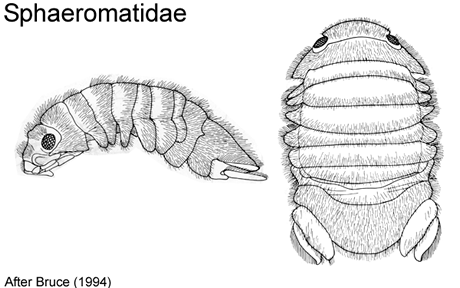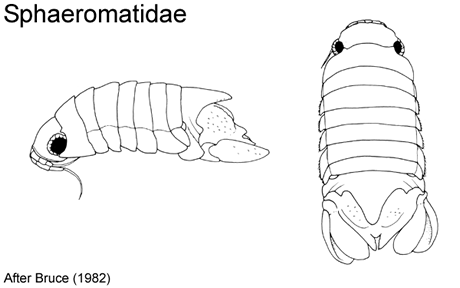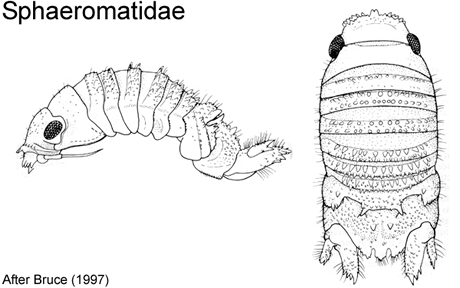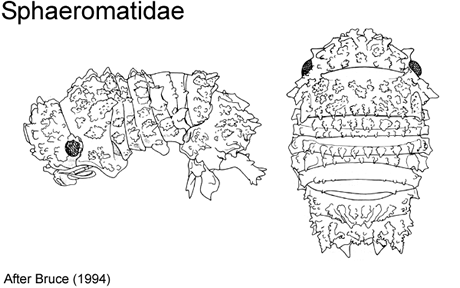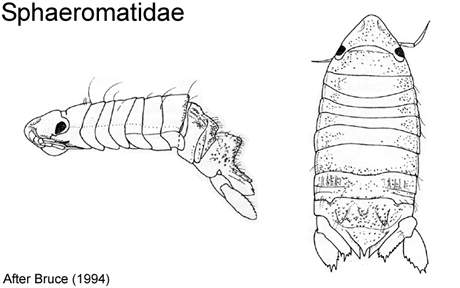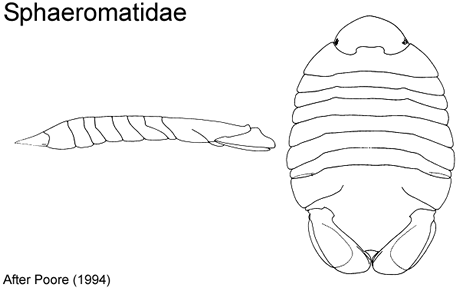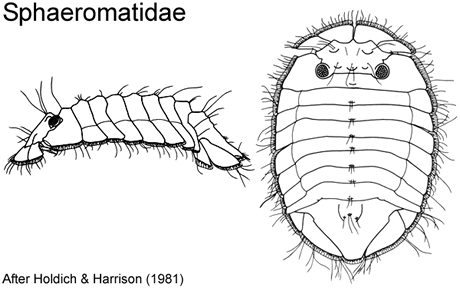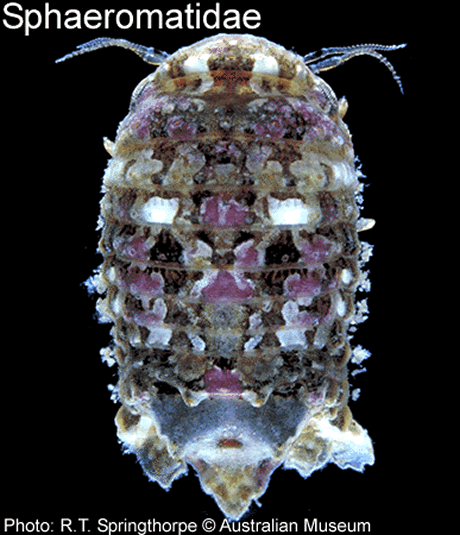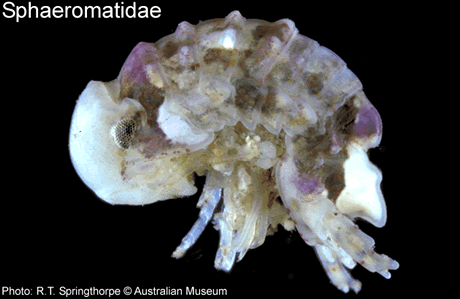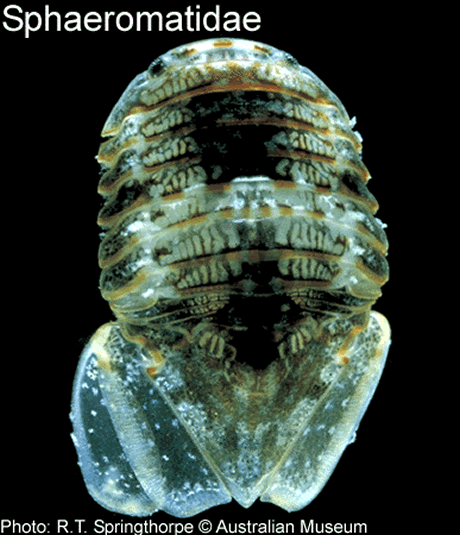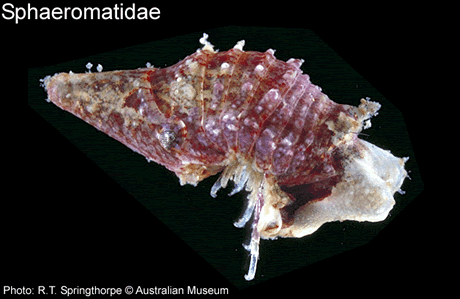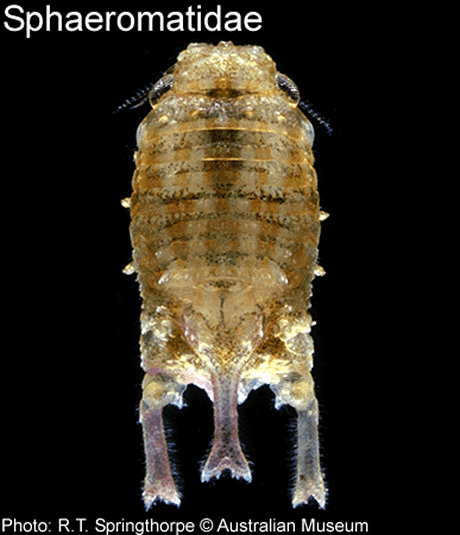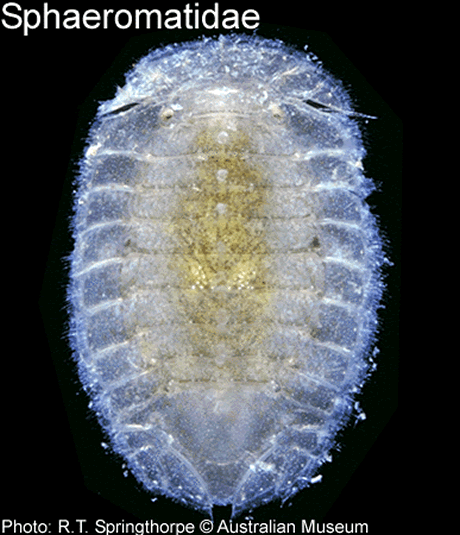 |
||||||
|
|
|
|
|
|
Australian Isopoda: FamiliesS.J. Keable, G.C.B. Poore & G.D.F. WilsonSphaeromatidae Latreille, 1825 Sphaeromides Latreille, 1825: 294. Sphaeromatidae. -Bruce, 1993a: 155. -Roman & Dalens, 1999: 233. Description. Body. Body shape without loss or gross modification of appendages on one side of the body; in dorsal view strongly dorsoventrally compressed, coxae splayed laterally, smoothly ovate in outline, expanded peduncular articles of antenna 1 only helping to define ovate outline or without peduncular articles of antenna 1 or 2 contiguous with coxal margins; in lateral view weakly convex, not able to roll into ball, or strongly convex, able to roll into a ball. Head. Head not capable of lateral rotation (laterally encompassed, abutting or fused to pereonite 1). Antenna 1 inserting on head anteriorly and/or dorsally to antenna 2, minute or well developed; not as follows: reduced to 2 articles with second article expanded and scalloped. Antenna 2 well developed. Mouthparts not forming suctorial cone or proboscis. Mandible not projecting anteriorly and together forceps-like; spine row not forming obvious circular raised cusp with spines on margin, may be vestigial or absent; molar not forming prominent triangular process projecting beyond body of mandible with spines along distal margin, may be vestigial or absent; palp present, or absent. Maxillule lateral lobe apex without hooked robust setae. Maxilliped endite conspicuous. Pereon. Pereonites 6-7 pereonite 7 distinct dorsally, free. Coxae extending ventrally and laterally to overhang the coxa-basis articulation of the pereopods. Coxa 1 and pereonite 1 fused. Pereopods 6-7 pairs readily apparent; 1-3 or 1-7 not prehensile. Pereopods 5-7 without flattened setose articles andor dactyls modified or absent. Pleon / Pleotelson. Pleonites and pleotelson with pleonites 1-5 fused with conspicuous lateral sutures, pleotelson fused to pleonites 1-5, or pleonite 1 unfused, pleonites 2-5 fused with partial (usually lateral) sutures, pleotelson wholly or partly fused with pleonites 2-5, or not arranged as follows: pleonites 1-5 fused but with conspicuous lateral sutures, pleotelson fused to pleonites 1-5; pleonites 1-5 fused but with conspicuous lateral sutures, pleotelson not fused to pleonites 1-5; pleonites 1-5 fused without conspicuous sutures, pleotelson not fused to pleonites 1-5; pleonites 2-5 fused but with partial (usually lateral) sutures, pleotelson wholly or partly fused with pleonites 2-5; pleonites 3-5 fused without lateral sutures, pleotelson fused with pleonites 3-5, pleonites 1 and 2 free but may be only small rings or cuticular bars visible ventrally. Pleonite 5 subequal to or shorter than any of pleonites 1-4. Pleopods 5 pairs present. Pleopod 2 of males not consisting of an enlarged peduncle with a geniculate endopod and a small muscular exopod. Uropods positioned proximally on pleotelson, or positioned distally on pleotelson; distinct from pleopods, not forming operculum over pleopodal chamber (although may be folded ventrally below pleotelson). Peduncle not forming an elongate clavate article with rami reduced or absent; fused to endopod (when endopod present). Endopod present or absent, not claw-like (acute and recurved) andor posteroventral in position. Exopod absent, or present; not folded dorsally over pleotelson. Distribution and generic composition. See Kensley et al. (1996).
Cite this publication as: 'S.J. Keable, G.C.B. Poore & G.D.F. Wilson (2002 onwards). 'Australian Isopoda: Families. Version: 2 October 2002. https://crustacea.net'. |
|
|
|
|
|
|
|
|
|
Copyright © Australian Museum, 2002 - 2003
Australian Museum website
